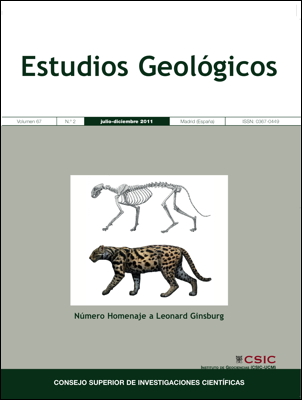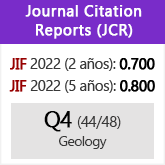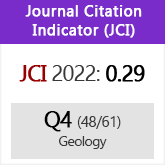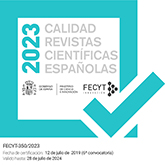Morotochoerus de Uganda (17.5 Ma) y Kenyapotamus de Kenia (13-11 Ma): implicaciones sobre el origen de los hipopotámidos
DOI:
https://doi.org/10.3989/egeol.40393.205Palabras clave:
Morotochoerinae, Morotochoerus, Kenyapotamus, Hippopotamidae, Palaeochoeridae, Cetartiodactyla, Africa, Miocene, EvolutionResumen
El objetivo de este trabajo es describir e interpretar los dientes suiformes de Moroto, Uganda, y Ngorora, Kenia, que contribuyen al debate sobre las relaciones hipo-anthracothere-whale. Las primeras etapas de la evolución de los hipopotámidos son relativamente poco conocidas a causa de la escasez de su registro fósil en edades superiors a los 7 Ma. Nuevos ejemplares de Morotochoerus en Uganda revelan que no están estrechamente relacionados con Hippopotamidae, las semejanzas superficiales de los dientes de la mandíbula con los de los hipopótamos representan convergencias y no homologías. Algunas muestras de Palaeopotamus ternani aparecen en el Medio Mioceno de Kenia {Maboko, ca 16 Ma; Muruyur, ca 14.5 Ma; Fort Ternan, ca 13.7 Ma}, mientras que desde la base del Mioceno tardío, Kenyapotamus coryndonae aparece en Kenia {Ngerngerwa, ca 10.5-10 Ma; Nakali, ca 10.5 Ma; Samburu Hills, ca 9,5 Ma}, {Ch’orora Etiopía, ca 10.5 Ma} {y Túnez Beglia Formación ca 11-10 Ma}. La obtención de especímenes de Kenyapotamus de la Formación Ngorora, Kenya, con edad ca 11 Ma, es de interés porque incluye dientes bien conservados, incluyendo un m/3 en buenas condiciones. Estos ejemplares apoyan la hipótesis de que los hipotámidos descienden de paleoquéridos y no de antracotéridos.
Descargas
Citas
Andrews, P.J. (1978). A revision of the Miocene Hominoidea of East Africa. Bulletin of the British Museum of Natural History, 30: 85-224.
Baksi, (1993). A geomagnetic polarity time scale for the period 0-17 Ma, based on 40Ar/39Ar Plateau ages for selected field reversals. Geophysics Research Letters, 20: 1607-1610.
Boisserie, J.-R.; Lihoreau, F. & Brunet, M. (2005a). The position of Hippopotamidae within Cetartiodactyla. Proceedings of the National Academy of Sciences, 102: 1537-1541. http://dx.doi.org/10.1073/pnas.0409518102 PMid :15677331 PMCid:547867
Boisserie, J.-R.; Lihoreau, F. & Brunet, M. (2005b). Origins of Hippopotamidae (Mammalia, Cetartiodactyla): towards resolution. Zoologica Scripta, 34: 119-143. http://dx.doi.org/10.1111/j.1463-6409.2005.00183.x
Boisserie, J.-R.; Lihoreau, F.; Orliac, M.; Fisher, R. & Weston, E. (2009a). Elucidating hippo relationships within Cetartiodactyla: dental evidence. Journal of Vertebrate Paleontology, Abstracts, 29: 67A.
Boisserie, J.-R.; Lihoreau, F.; Orliac, M.; Fisher, R.; Weston, E. & Ducrocq, S. (2009b). Morphology and phylogenetic relationships of the earliest known hippopotamids (Cetartiodactyla, Hippopotamidae, Kenyapotaminae). Zoological Journal of the Linnean Society, 2009.
Cande, S. & Kent, D. (1995). Revised calibration of the geomagnetic polarity timescale for the Late Cretaceous and Cenozoic. Journal of Geophysics Research, 100: 6093-6095. http://dx.doi.org/10.1029/94JB03098
Coryndon, S.C. & Coppens, Y. (1975). Une espèce nouvelle d’Hippopotame nain du Plio-Pléistocène du Bassin du Lac Rodolphe (Ethiopie, Kenya). Comptes Rendus de l’Académie des Sciences, Paris, 280: 1777- 1780.
Cuvier, G. (1804). Sur quelques dents et os trouvés en France qui paroissent avoir appartenu à des animaux du genre du Tapir. Annales du Muséum national d’Histoire naturelle, 3, 132-143.
Delson, E. (1979). Oreopithecus is a cercopithecoid after all. American Journal of Physical Anthropology, 50(3): 431-432.
Deraniyagala, P.E.P. (1944). Some mammals of the extinct Ratnapura fauna of Ceylon. Spolia zeylanica, 24 (1): 19-56.
Falconer, H. (1868). Palaeontological Memoirs, vol. 1, Fauna Antiqua Sivalensis.
Gebo, D.; MacLatchy, L. & Kityo, R. (1997a). A new lorisid humerus from the Early Miocene of Uganda. Primates, 38: 423-427. http://dx.doi.org/10.1007/BF02381882
Gebo, D.L.; MacLatchy, L.; Kityo, R.; Deino, A.; Kingston, J. & Pilbeam, D. (1997b). A hominoid genus from the Early Miocene of Uganda. Science, 276: 401-404. http://dx.doi.org/10.1126/science.276.5311.401 PMid :9103195
Gingerich, P. & Uhen, M. (1998). Likelihood estimation of the time of origin of Cetacea and the time of divergence of Cetacea and Artiodactyla. Palaeontologia Electronica, 1: 1-47.
Gray, J.E. (1821). On the natural arrangement of vertebrose animals. London Medical Repository, 15: 296- 310.
Hooijer, D.A. (1952). Fact and fiction in Hippopotamology (sampling the history of scientific error). Osiris, 10: 109-116. http://dx.doi.org/10.1086/368549
Hünermann, K.A. (1968). Die Suidae (Mammalia, Artiodactyla) aus den Dinotheriensanden (Unterpliozän = Pont) Rheinhessens (Sudwestdeutschland). Schweizerische Palaeontologische Abhandlungen, Mémoires Suisses de Paléontologie, Basel, 86: 1-96.
Kelley, J. (2005). Misconceptions arising from the misassignment of non-hominoid teeth to the Miocene hominoid Sivapithecus. Palaeontologica Electronica, 8(1) 16A: 1-19.
Kempf, O.; Bolliger, T.; Kälin, D.; Engesser, B. & Matter, A. (1997). New Magnetostratigraphic calibration of Early to Middle Miocene mammal biozones of the North Alpine Foreland Basin. Actes du Congrès BiochroM’ 97, Mémoires et Travaux de l’Ecole Pratique des Hautes Etudes, Institut de Montpellier, 21: 547-561.
Leidy, J. (1869). Extinct Mammalia of Dakota and Nebraska, including an account of some allied forms from other localities. Journal of the Academy of Natural Sciences, Philadelphia, 7: 23-472.
MacLatchy, L. & Kityo, R. (2002). A Lower Miocene Lorid femur from Napak, Uganda. American Association of Physical Anthropologists, Abstracts, 2002: 104- 105.
MacLatchy, L.; Downs, W.; Kityo, R.; Mafabi, M. & Musiime, E. (2003). New catarrhine fossils from the lower Miocene of Uganda, with implications for the ape-monkey split. Paleoanthropology Society Abstract, 2003: 17-18.
Matthew, W.D. (1924). Third contribution to the Snake Creek fauna. Bulletin of the American Museum of Natural History, 50: 59-210.
Matthew, W.D. (1934). A phylogenetic chart of the Artiodactyla. Journal of Mammalogy, 1: 207-209. http://dx.doi.org/10.2307/1373852
Montgelard, C.; Catzeflis, F. & Douzery E. (1997). Phylogenetic relationships of artiodactyls and cetaceans as deduced from the comparison of cytochrome b and 12S rRNA mitochondrial sequences. Molecular Biology and Evolution, 14: 550-559. http://dx.doi.org/10.1093/oxfordjournals.molbev.a025792 PMid :9159933
Orliac, M.; Lihoreau, F.; Boisserie, J.-R. & MacLatchy, L. (2009). Revision of the African palaeochoerids: implications for the relationships of Hippopotamidae (Cetartiodactyla, Mammalia). Journal of Vertebrate Paleontology, Abstracts, 29: 159A.
Orliac, M.A.; Boisserie, J.R.; MacLatchy, L. & Lihoreau, F. (2010). Early Miocene hippopotamids (Cetartiodactyla) constrain the phylogenetic and spatiotemporal settings of hippopotamid origin. Proceedings of the National Academy of Sciences.
Osborn, H. (1922). Hesperopithecus, the first anthropoid primate found in America. American Museum Novitates, 37: 1-5.
Pickford, M. (1983). On the origins of the Hippopotamidae together with a description of two new species, a new genus and a new subfamily from the Miocene of Kenya. Geobios, 16: 193-217. http://dx.doi.org/10.1016/S0016-6995(83)80019-9
Pickford, M. (1984). A revision of the Sanitheriidae (Suiformes, Mammalia) Geobios, 17: 133-154. http://dx.doi.org/10.1016/S0016-6995(84)80139-4
Pickford, M. (1988). Revision of the Miocene Suidae of the Indian Subcontinent. Münchner Geowissenschaftliche Abhandlungen, 12: 1-91.
Pickford, M. (1998a). Dating of the Neogene Old World anthropoid fossil record: essential base for phylogenetic analysis, biogeography and palaeoecology. Primatologie, 1: 27-92.
Pickford, M. (1998b). A new genus of Tayassuidae (Mammalia) from the middle Miocene of Uganda and Kenya. Annales de Paléontologie, 84: 275-285. http://dx.doi.org/10.1016/S0753-3969(99)80003-2
Pickford, M. (2007a). Suidae and Hippopotamidae from the Middle Miocene of Kipsaraman, Kenya, and other sites in East Africa. Paleontological Research, 11: 85-105. http://dx.doi.org/10.2517/1342-8144(2007)11[85:SAHFTM]2.0.CO;2
Pickford, M. (2007b). A new rare suiform (Artiodactyla, Mammalia) from the early Miocene of East Africa. Comptes Rendus Palevol, 6: 221-229. http://dx.doi.org/10.1016/j.crpv.2006.11.002
Pickford, M. (2008). The myth of the hippo-like anthracothere: The eternal problem of homology and convergence. Revista Española de Paleontologia, 23: 31-90.
Pickford, M.; Senut, B. & Gommery, D. (1999). Sexual dimorphism in Morotopithecus bishopi, an early Middle Miocene hominoid from Uganda and a reassessment of its geological and biological contexts. In: Late Cenozoic Environments and Hominid Evolution: a Tribute to Bill Bishop (Andrews, P. & Banham, P., eds). Geological Society, London, 27-38.
Pickford, M.; Senut, B.; Hadoto, D.; Musisi, J. & Kariira, C. (1986). Découvertes récentes dans les sites miocènes de Moroto (Ouganda Oriental): aspects biostratigraphiques et paléoécologiques. Comptes Rendus de l'Academie des Sciences de Paris, 302: 681-686.
Pickford, M. & Tiwari, B.N. (2010). Precisions concerning the distribution and identification of Miocene hominoids from India. Revista Española de Paleontología, 25: 107-121.
Tsujikawa, H. (2005). The updated Late Miocene large mammal fauna from Samburu Hills, northern Kenya. African Study Monographs, Supplement, 32: 1-50.
Van der Made, J. (1996). Listriodontinae (Suidae, Mammalia), their evolution, systematics and distribution in time and space. Contributions to Tertiary and Quaternary Geology, 33: 1-254.
Van der Made, J. (1999). Superfamily Hippopotamoidea. In: The Miocene Land Mammals of Europe (Rössner, G. & Heissig, K., eds), München, Friedrich Pfeil Verlag, 203-208.
Viret, J. (1929). Les faunes de mammifères de l’Oligocène supérieur de la Limagne Bourbonnaise. Annales de l’Université de Lyon, Nouvelle série 1, 47: 1-329.
Young, N.M. & MacLatchy, L. (2004). The phylogenetic position of Morotopithecus. Journal of Human Evolution, 46: 163-184. http://dx.doi.org/10.1016/j.jhevol.2003.11.002 PMid :14871561
Descargas
Publicado
Cómo citar
Número
Sección
Licencia
Derechos de autor 2011 Consejo Superior de Investigaciones Científicas (CSIC)

Esta obra está bajo una licencia internacional Creative Commons Atribución 4.0.
© CSIC. Los originales publicados en las ediciones impresa y electrónica de esta Revista son propiedad del Consejo Superior de Investigaciones Científicas, siendo necesario citar la procedencia en cualquier reproducción parcial o total.Salvo indicación contraria, todos los contenidos de la edición electrónica se distribuyen bajo una licencia de uso y distribución “Creative Commons Reconocimiento 4.0 Internacional ” (CC BY 4.0). Puede consultar desde aquí la versión informativa y el texto legal de la licencia. Esta circunstancia ha de hacerse constar expresamente de esta forma cuando sea necesario.
No se autoriza el depósito en repositorios, páginas web personales o similares de cualquier otra versión distinta a la publicada por el editor.

















